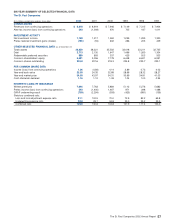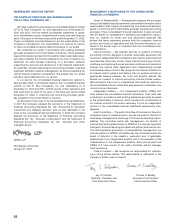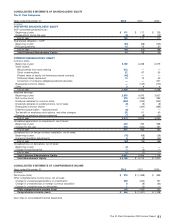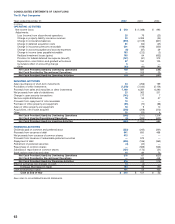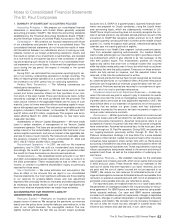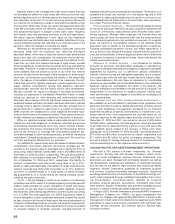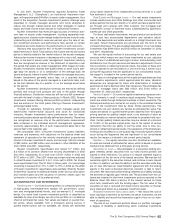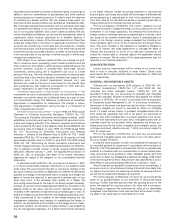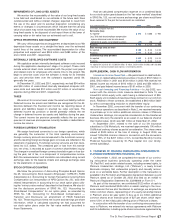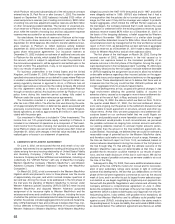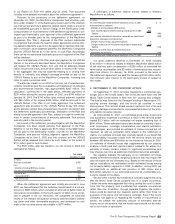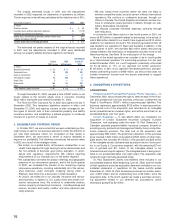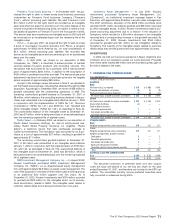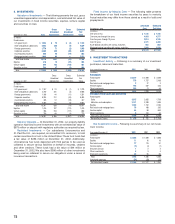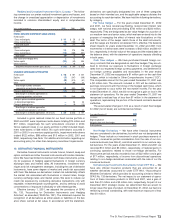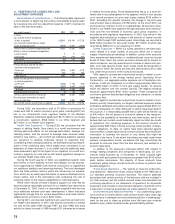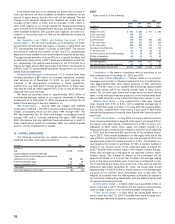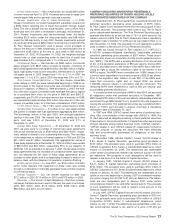Travelers 2002 Annual Report Download - page 69
Download and view the complete annual report
Please find page 69 of the 2002 Travelers annual report below. You can navigate through the pages in the report by either clicking on the pages listed below, or by using the keyword search tool below to find specific information within the annual report.
IMPAIRMENTS OF LONG-LIVED ASSETS
We monitor the recoverability of the value of our long-lived assets
to be held and used based on our estimate of the future cash flows
(undiscounted and without interest charges) expected to result from
the use of the asset and its eventual disposition considering any
events or changes in circumstances which indicate that the carrying
value of an asset may not be recoverable.We monitor the value of our
long-lived assets to be disposed of and report them at the lower of
carrying value or fair value less our estimated cost to sell.
OFFICE PROPERTIES AND EQUIPMENT
We carry office properties and equipment at depreciated cost. We
depreciate these assets on a straight-line basis over the estimated
useful lives of the assets. The accumulated depreciation for office
properties and equipment was $504 million and $483 million at the
end of 2002 and 2001, respectively.
INTERNALLY DEVELOPED SOFTWARE COSTS
We capitalize certain internally developed software costs incurred
during the application development stage of a project. These costs
include external direct costs associated with the project and payroll
and related costs for employees who devote time to the project. We
begin to amortize costs once the software is ready for its intended
use, and amortize them over the software’s expected useful life,
generally five years.
At December 31, 2002 and 2001, respectively, we had $54 million
and $50 million of unamortized internally developed computer soft-
ware costs and recorded $12 million and $7 million of amortization
expense during 2002 and 2001, respectively.
TAXES
We account for income taxes under the asset and liability method.
Deferred income tax assets and liabilities are recognized for the dif-
ferences between the financial and income tax reporting bases of
assets and liabilities based on enacted tax rates and laws. The
deferred income tax provision or benefit generally reflects the net
change in deferred income tax assets and liabilities during the year.
The current income tax provision generally reflects the tax conse-
quences of revenues and expenses currently taxable or deductible on
income tax returns.
FOREIGN CURRENCY TRANSLATION
We assign functional currencies to our foreign operations, which
are generally the currencies of the local operating environment.
Foreign currency amounts are remeasured to the functional currency,
and the resulting foreign exchange gains or losses are reflected in the
statement of operations. Functional currency amounts are then trans-
lated into U.S. dollars. The unrealized gain or loss from this transla-
tion, net of tax, is recorded as a part of common shareholders’ equity.
The change in unrealized foreign currency translation gain or loss dur-
ing the year, net of tax, is a component of comprehensive income.
Both the remeasurement and translation are calculated using current
exchange rates for the balance sheets and average exchange rates
for the statements of operations.
STOCK OPTION ACCOUNTING
We follow the provisions of Accounting Principles Board Opinion
No. 25, “Accounting for Stock Issued to Employees” (“APB 25”), FASB
Interpretation 44, “Accounting for Certain Transactions involving Stock
Compensation (an interpretation of APB Opinion No. 25),” and other
related interpretations in accounting for our stock option plans utiliz-
ing the “intrinsic value method” described in that literature.We also fol-
low the disclosure provisions of SFAS No. 123, “Accounting for
Stock-Based Compensation” for our option plans, as amended by
SFAS No. 148, “Accounting for Stock-Based Compensation —
Transition and Disclosure; an amendment of FASB Statement
No. 123”. These require pro forma net income and earnings per share
information, which is calculated assuming we had accounted for
our stock option plans under the “fair value method” described in
those Statements.
Had we calculated compensation expense on a combined basis
for our stock option grants based on the “fair value method” described
in SFAS No. 123, our net income and earnings per share would have
been reduced to the pro forma amounts as indicated.
Years ended December 31 2002 2001 2000
($ in millions, except per share data)
Net income (loss)
As reported * $218 $(1,088) $ 993
Less: Total stock-based employee compensation
expense determined under fair value based
method for all awards, net of related tax effects (37) (25) (4)
Pro forma $181 $(1,113) $ 989
Basic earnings (loss) per share
As reported $0.94 $(5.22) $ 4.50
Pro forma $0.77 $(5.33) $ 4.48
Diluted earnings (loss) per share
As reported $0.92 $(5.22) $ 4.24
Pro forma $0.77 $(5.33) $ 4.24
*As reported net income or loss included $8 million, $5 million, and $18 million for 2002, 2001 and 2000,
respectively, in stock-based compensation expenses, net of related tax benefits.
SUPPLEMENTAL CASH FLOW INFORMATION
Interest and Income Taxes Paid — We paid interest on debt and dis-
tributions on redeemable preferred securities of trusts of $167 million in
2002, $133 million in 2001 and $134 million in 2000. We received net
federal income tax refunds of $100 million in 2002 and $54 million in
2001, and paid federal income taxes of $161 million in 2000.
Non-cash Investing and Financing Activities — In July 2002, con-
current with the common stock issuance described in Note 13, we
issued 8.9 million equity units, each having a stated amount of $50.
Each equity unit included a forward purchase contract on our common
stock. Related to these contracts, we established a $46 million liabil-
ity, with a corresponding reduction to shareholders’ equity.
In November 2002, concurrent with the transfer of our continuing
reinsurance operations as described in Note 2, we received warrants
to purchase up to six million additional common shares of Platinum
Underwriters Holdings, Ltd. as partial consideration for the transferred
business. We carry the warrants as an asset on our balance sheet at
their market value, which was $61 million at December 31, 2002.
In September 2001, related to the sale of our life insurance
subsidiary to Old Mutual plc, we received approximately 190 million
Old Mutual ordinary shares as partial consideration.The shares were
valued at $300 million at the time of closing. In August 2000, we
issued 7,006,954 common shares in connection with the conversion
of over 99% of the $207 million of 6% Convertible Monthly Income
Preferred Securities issued by St. Paul Capital LLC (our wholly-
owned subsidiary).
2. TRANSFER OF ONGOING REINSURANCE OPERATIONS TO
PLATINUM UNDERWRITERS HOLDINGS, LTD.
On November 1, 2002, we completed the transfer of our continu-
ing reinsurance business (previously operating under the name
“St. Paul Re”) and certain related assets, including renewal rights, to
Platinum Underwriters Holdings, Ltd. (“Platinum”), a newly formed
Bermuda company that underwrites property and casualty reinsur-
ance on a worldwide basis. Further description of the transaction is
available in the Formation and Separation Agreement between us and
Platinum dated as of October 28, 2002 and filed as an exhibit to
Platinum’s Registration Statement No. 333-86906 on Form S-1.
As part of this transaction, we contributed $122 million of cash to
Platinum and transferred $349 million in assets relating to the insur-
ance reserves that we also transferred. In exchange, we acquired six
million common shares, representing a 14% equity ownership interest
in Platinum and a ten-year option to buy up to six million additional
common shares at an exercise price of $27 per share, which repre-
sents 120% of the initial public offering price of Platinum’s shares.
In conjunction with the transfer of our continuing reinsurance busi-
ness to Platinum, we entered into various agreements with Platinum
and its subsidiaries, including quota share reinsurance agreements by
The St. Paul Companies 2002 Annual Report 67


